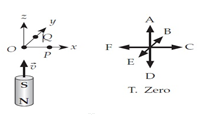Most of the planets discovered around other stars
A) are more massive than Earth and orbit very far from the star.
B) are more massive than Earth and orbit very close to the star.
C) are less massive than Earth and orbit very far from the star.
D) are less massive than Earth and orbit very close to the star.
E) are found around neutron stars.
B
You might also like to view...
Polarized light is to have its polarization plane rotated by 90°. In which of the following cases does the final beam have the greatest intensity?
a. 3 polarizing filters, each rotate beam by 30°. b. 2 polarizing filters, both rotate beam by 45°. c. 1 polarizing filter, rotating beam by 90°. d. None of the above, polarized light can't be rotated.
As the air cools at night the relative humidity usually __________
Fill in the blank(s) with correct word
Imagine that the magnet is moving downward instead of upward.  In this situation, specify the directions of each of the vector quantities described below. Use the answer chart provided above and to the right (note that answers B and E refer to the +y and -y directions, respectively). What is the direction of
In this situation, specify the directions of each of the vector quantities described below. Use the answer chart provided above and to the right (note that answers B and E refer to the +y and -y directions, respectively). What is the direction of  at the origin (point O)?
at the origin (point O)?
A. A B. B C. C D. D E. E F. F T. Zero
What element dominates the ice on the surface of Pluto?
a. methane b. nitrogen c. hydrogen d. carbon monoxide e. carbon dioxide